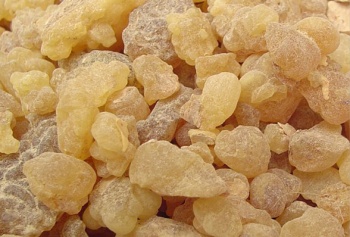Frankincense
Other Names: Arbre à Encens, Bible Frankincense, Boswellia carteri, Boswellia carterii, Boswellia sacra, Boswellie, Encens, Incense, Oleo-gum-resin, Oléo-Gomme-Résine, Oliban, Olibanum, Levonah, Luban, KhunkRu Xiang, Ru Xiang Shu.
See also : Indian Frankincense
Frankincense resin and oil is obtained from Boswellia, a genus of trees that are common in Asia, Africa, India and the Middle East. Frankincense was used for thousands of years as a base for perfume. Frankincense was also used in traditional medicines to treat inflammatory disorders such as rheumatoid arthritis and Crohn's disease. According to published scientific literature, frankincense may also play an important role in cancer treatment; however, data is limited.
Contents
Special Precautions of Frankincense
- See warnings about Aromatherapy
- Frankincense essential oil should not be taken internally without the supervision of a health professional. Internal use of frankincense essential oil may have toxic effects.
- In addition, some individuals may experience irritation or an allergic reaction when applying frankincense essential oil to the skin. A skin patch test should be done before using any new essential oil.
- Pregnant or nursing women and children should consult their health care providers before using essential oils.
- It's also important to note that self-treating a chronic condition with frankincense essential oil and avoiding or delaying standard care may have serious consequences.
- Tisserand and Young precaution to avoid use of the oil if it has oxidized. Skin sensitization is more likely when using oxidized Frankincense Oil.
- Cinical Data : Although a lot of scientific data supports a possible role for frankincense in cancer treatment, according to NIH, all the experiments were performed in cells or in animal studies. Cells, while a good tool in cancer studies, do not fully explain the possible effect of frankincense in the human body. More studies are necessary to determine if frankincense is truly a valid treatment option.
The benefits of Frankincense are
- Prostate Cancer : In the March 2010 issue of "Molecular Pharmacology," Dr. Aydee C. Estrada, et al., reported on the effects of tirucallic acids against prostate cancer. Tirucallic acids are the active ingredients found in frankincense. Dr. Estrada found that tirucallic acids extracted from frankincense successfully killed cultured human prostate cancer cells that were experimentally grafted into mice, by inducing the expression of proteins that are important in apoptosis. Apoptosis is a cell process that produces cellular death and is a process most cancers have learned to avoid.
- Leukemia : Acute myeloid leukemia, or AML, is a cancer that occurs in the bone marrow and originates in cells that eventually develop into white blood cells of the immune system. AML is rare in children and generally only affects adults over the age of forty. In the March 2005 issue of "Molecular Cancer Therapy," Dr. Lijuan Xia, et al., reported that in laboratory-based experiments, resin from frankincense extract successfully induced apoptosis, increasing cell death by approximately 40 percent in leukemia cells.
- Kidney Cancer : Using human bladder cancer cell lines, as reported in the March 2009 issue of "BMC Complementary and Alternative Medicine," Dr. Mark Barton Frank, et al., illustrated that frankincense was cytotoxic for bladder tumor cells. In other words, frankincense might provide benefit against bladder cancer by killing cancer cells, while not affecting normal cells. Further experiments are necessary to verify the results.
- Ovarian Cancer : According to researchers at the University of Leicester, it has been discovered that frankincense contains cancer-killing properties for ovarian cancer. The compound AKBA (acetyl-11-keto-beta-boswellic acid) in frankincense has the ability to target cancer cells in late-stage ovarian patients.
- Bladder Cancer : A recent paper published in the journal Chinese Medicine identified sandalwood’s anti-cancer potential alongside that of a related oil, frankincense. Operating in coordinated but distinct ways, these two precious oils were observed to both promote cancer cell death and inhibit cancer cell potency. The latter effect is where sandalwood oil really got to show off its power, halting the viability of two particular cells implicated in human bladder cancers: J82 and UROtsa. Like frankincense oil, sandalwood was shown to activate certain signaling pathways in order to fight against these cells, but its mode of achieving this was found to be distinct from its partnered oil.
- inflammatory diseases : Frankincense is also used in traditional medicines to treat inflammatory disorders such as rheumatoid arthritis, osteoarthritis and Crohn's disease. Compounds in Boswellia extract have been shown to bind directly to 5-LOX, an enzyme that transforms fatty acids into inflammatory factors like leukotriene B4. A compound in boswellia called AKBA is the key to this beneficial action. AKBA (3-0-acetyl-keto-beta-boswellic acid) is one of the active ingredients in frankincense and has anti-inflammatory properties.
- acne
- anxiety
- asthma
- bronchitis
- colds
- coughs
- indigestion
- ulcers
- to alleviate stress and relieve pain.
- skin-care products, frankincense essential oil is said to treat dry skin, reverse signs of aging, and reduce the appearance of scars and stretch marks.
Used in Patent Medicine
References
Robert Tisserand and Rodney Young, Essential Oil Safety (Second Edition. United Kingdom: Churchill Livingstone Elsevier, 2014), 287-289.
